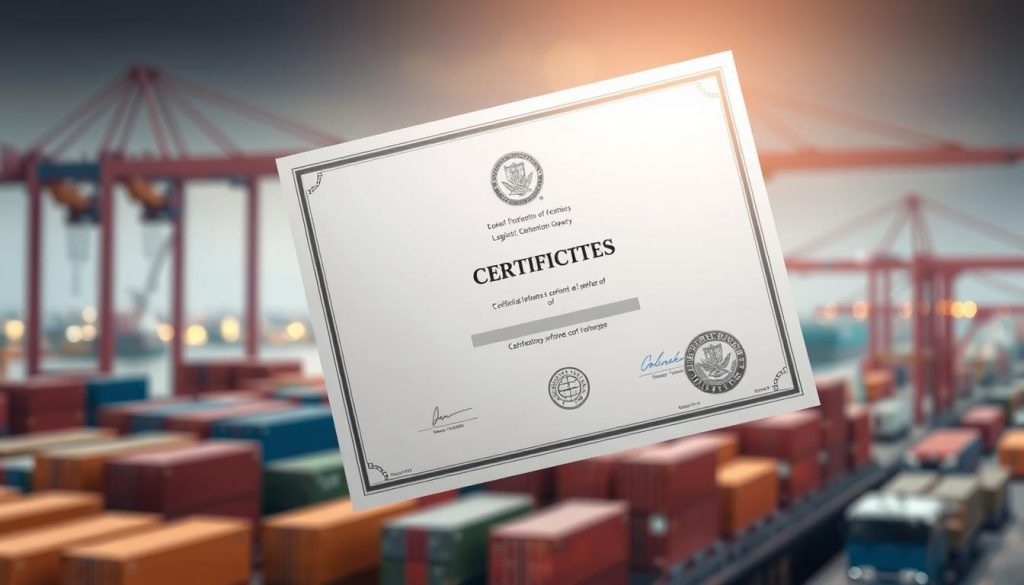Earn a Logistics Certification: Advance Your Career
In the U.S., employers look for verifiable credentials to gauge a candidate’s skills in supply chain, transportation, and operations. This piece explores how a logistics certification can boost hiring success and readiness for promotions. It delves into recognized logistics certification paths that align with competency standards of top companies.
It discusses Supply Chain Canada’s Supply Chain Management Professional (SCMP) designation and structured logistics certification programs focused on practical learning. The curricula include Business Mathematics (4.0 credits), Business Statistics (5.5), and International Trade 1 (3.0). Other courses are Canada Customs and Free Trade Agreements (4.0), Transportation Economics (4.0), International Trade 2 (3.0), and Logistics Management (4.5). These add up to 49.0 credits.
The review also examines the Logistics Institute’s programs: Logistics Essentials for beginners, Supply Chain & Logistics Foundations for new supervisors, and the Optimization program for experienced professionals. Each program is designed to align with the SKA nexus—Skills, Knowledge, and Aptitude. This ensures graduates can show measurable skills valued in the industry.
It provides a detailed overview of SCMP’s structure: eight modules across various areas, six workshops, a Leadership Residency, a final case-based exam, and a three-year practical experience requirement. To apply, one must be a Supply Chain Canada member, meet language proficiency standards, and have a business degree or at least five years of supply chain experience.
The aim is to offer practical advice. By comparing logistics certification programs, this section helps readers choose a recognized certification. It supports career growth, salary increases, and credible leadership in the U.S. market.
Why a Professional Logistics Certification Elevates Your Career in the U.S.
In the U.S., employers value proven skills over theory. A professional logistics certification or logistics management certification proves your hands-on expertise. It shows measurable skills that lead to quicker adaptation, lower risks, and consistent outcomes.
Stronger hiring appeal and promotion opportunities
Credentials are seen as proof of readiness by recruiters. Many job postings in supply chain roles require SCMP designation. This status signals to employers that you’re ready for planning, sourcing, logistics, and transportation roles.
The Logistics Institute offers tiered pathways. These include Logistics Essentials, Supply Chain & Logistics Foundations, and Optimization. These paths align training with job roles, making it easier to move up from coordinator to manager to director with a professional logistics certification.
Higher earning power and leadership credibility
SCMP holders see an average earnings boost of about 22% compared to non-holders. This premium reflects their advanced skills, broader decision-making authority, and greater responsibility for costs, service, and risk.
Having this credential makes you a strategic leader. You can justify investments, optimize networks, and manage volatility. For managers, a logistics management certification earns trust from executives and finance by linking actions to KPIs and cash flow.
Transferable skills across supply chain, transportation, and operations
Programs focus on the SKA nexus—Skills, Knowledge, and Aptitude. This ensures your skills are transferable across various areas like procurement, logistics and transportation, operations, and public sector supply chain.
Coursework includes Business Mathematics, Business Statistics, International Trade 1 & 2, customs and FTAs, Transportation Economics, and Logistics Management. These courses develop skills in analysis, compliance, and planning. An industry recognized logistics certification showcases these skills to hiring teams in freight forwarding and end-to-end supply chain roles.
Industry-Recognized Programs: What Employers Look For
U.S. employers assess a logistics certification based on three key aspects: competency alignment, applied learning, and institutional recognition. Those who opt for an industry recognized logistics certification or a supply chain certification that meets these standards demonstrate credible, job-ready skills.
Credentials aligned to competency standards (skills, knowledge, aptitude)
Top programs align with established frameworks. The Logistics Institute’s SKA nexus connects skills, knowledge, and aptitude to specific roles in warehousing, transportation, and procurement. This approach allows hiring managers to assess capability accurately, avoiding the uncertainty of guessing.
For job seekers, a logistics certification that references SKA alignment provides clear evidence of problem-solving, analytics, and decision-making skills. This evidence reduces the risk of onboarding for employers.
Applied learning with immediate on-the-job impact
Supply Chain Canada’s SCMP focuses on practical application, not just theory. It includes eight knowledge modules and six interactive workshops with real-world cases, projects, and participation assessments. The program concludes with a case-based final exam.
The evaluation emphasizes practical skills: module work and participation account for 30%, workshops for 15%, Leadership Residency for 10%, and the final exam for 45%. This approach transforms theoretical knowledge into tangible performance, bolstering the value of an industry recognized logistics certification.
Recognition from established associations and institutes
Employers seek credentials endorsed by reputable bodies. SCMP’s recognition by Supply Chain Canada, with global insights from ASCM and NASCO, signifies governance and peer review. The inclusion of CITT and CIFFA electives, such as Transportation Systems and International Transportation and Trade, ensures market relevance.
Such affiliations distinguish a supply chain certification in North American job markets. They signify adherence to shared standards, current content, and networks that boost a logistics certification throughout a professional’s career.
SCMP Designation: A Strategic Supply Chain Certification Path
Supply Chain Canada sees the SCMP as the top credential for full supply chain leadership. U.S. employers often look for it in roles like procurement, logistics, and operations. This makes it a key supply chain certification for those aiming for careers across borders. It offers a deep mix of strategy, analytics, and governance, aligning with executive goals.
Why become a SCMP: impact, advancement, and earning power
Having the SCMP can lead to more influence in budget, sourcing, and service design. Job ads in North America often prefer SCMP holders, showing a path for career growth.
Salary surveys show SCMP professionals earn an average 22% more than others. This difference grows for leaders who also hold a logistics certification or a professional logistics certification focused on operations excellence.
Global perspective via ASCM and NASCO relationships
Supply Chain Canada works with ASCM and NASCO to integrate global practices into the SCMP. Learners get to work on cross-border cases, align with international standards, and learn from big names like Walmart and Deloitte.
This partnership makes the SCMP more valuable in the U.S. market. It also helps organizations meet compliance and trade needs along North American corridors.
Recognition as a strategic leader and decision-maker
The SCMP curriculum covers a wide range of topics, from procurement to global sourcing. It also includes knowledge management, public sector contexts, and services or major projects. Graduates show they understand finance, policy, and risk management, all key to adding value to an enterprise.
Employers see SCMP holders as ready for roles like PMO, category management, and network design. The SCMP complements logistics certifications by adding governance, negotiation, and data-driven strategy.
| SCMP Capability Area | Operational Outcome | Employer Signal |
|---|---|---|
| Procurement & Global Sourcing | Lower total cost of ownership and resilient supplier portfolios | Readiness for category lead and strategic sourcing roles |
| Logistics & Transportation | Optimized modes, improved on-time performance, controlled freight spend | Fit for network planning and transportation management |
| Operations & Risk | Stable service levels, scenario planning, and continuity safeguards | Trusted to lead S&OP and operational governance |
| Knowledge Management | Codified playbooks, analytics adoption, and repeatable results | Evidence of scalable process leadership |
| Public Sector & Major Projects | Policy-compliant sourcing and lifecycle cost control | Eligible for complex capital and government initiatives |
SCMP Program Structure and Requirements
The Supply Chain Management Professional (SCMP) pathway is designed for working managers aiming for logistics management certification. It meets the standards of major employers in North America. This makes it one of the most challenging logistics certification programs for strategic roles.
Candidates go through a structured program with modules, workshops, a leadership residency, and a final exam. The program focuses on practical learning and decision-making skills. This prepares them for an industry recognized logistics certification.
Eight modules: logistics and transportation, procurement, operations, and more
- Supply Chain Management
- Procurement and Supply Management
- Logistics and Transportation
- Operations and Process Management
- Knowledge Management
- Global Sourcing
- Supply Chain Management for the Public Sector
- Supply Chain Management for Services, Capital Goods and Major Projects
These modules form the foundation of logistics certification programs. They cover the entire supply chain process, from sourcing to delivery.
Six interactive workshops: leadership, negotiation, risk, ethics
- Leadership and Professionalism
- Negotiation Skills
- Communication and Relational Skills
- Competitive Bidding, Contract Preparation and Contract Management
- Risk Management
- Ethical Behavior and Social Responsibility
The workshops enhance soft skills essential for logistics management certification. These skills are directly applicable in the workplace.
Leadership Residency and final case-based exam
The Leadership Residency refines management skills before the Final Exam. The exam assesses problem-solving, cost evaluation, and policy adherence in procurement, logistics, and operations.
Practical work experience requirement (minimum three years)
Candidates need at least three years of supply chain experience. Roles can include purchasing, logistics, transportation planning, inventory control, or operations. This reflects the broad scope of an industry recognized logistics certification.
Admission: membership, language proficiency, education or experience
- Active Supply Chain Canada membership
- Language proficiency for non-native English or French speakers at CLB 6 or higher
- EITHER a business-related degree or diploma (or international equivalency) OR at least five years of relevant work or military experience
| Program Component | Focus Area | Assessment Weight | Professional Value |
|---|---|---|---|
| Eight Modules | Strategy, procurement, logistics, operations, sourcing, public sector, services/projects | 30% (assignments and participation) | Builds technical depth for logistics management certification |
| Six Workshops | Leadership, negotiation, communication, contracts, risk, ethics | 15% | Strengthens decision quality and stakeholder engagement |
| Leadership Residency | Integration of skills and executive practice | 10% | Prepares for capstone analysis in logistics certification programs |
| Final Exam | Comprehensive case-based evaluation | 45% | Validates readiness for an industry recognized logistics certification |
Logistics Institute Pathways: Certifications by Career Stage
The Logistics Institute offers certifications tailored to each career stage. Candidates choose based on their role and experience, from entry-level to senior management. Each certification is designed to enhance on-the-job skills, ensuring professionals meet industry standards.
All programs adhere to the SKA nexus—Skills, Knowledge, and Aptitude. This framework guarantees a certification that employers can trust and verify against clear benchmarks.
Logistics Essentials for newcomers to logistics and supply chain
Logistics Essentials is for those new to the field. It covers inventory management, transport basics, and workflow coordination. Graduates gain confidence in core terms, simple KPIs, and safety practices.
Supply Chain & Logistics Foundations for new supervisors
Foundations is for first-line supervisors. It focuses on people management and performance control. The program emphasizes shift planning, service level adherence, and exception handling. It equips emerging leaders to translate policy into daily results.
Optimization program for professionals with 10+ years’ experience
The Optimization program is for seasoned professionals managing networks and multi-site operations. It includes demand shaping, cost-to-serve analysis, and scenario modeling. This certification validates advanced decision-making and continuous improvement skills.
Competency-based learning aligned to SKA nexus
Each pathway is designed to align with job tasks and measurable metrics. It focuses on Skills, Knowledge, and Aptitude. This ensures certifications enhance performance, not just theory.
| Pathway | Ideal Candidate | Primary Outcomes (SKA) | Typical Modules | Assessment Format |
|---|---|---|---|---|
| Logistics Essentials | New entrants, 0–2 years | Skills: basic execution; Knowledge: process fundamentals; Aptitude: safe, reliable application | Inventory basics, transport modes, order processing, workplace safety | Quizzes, task simulations, supervisor-verified checklists |
| Supply Chain & Logistics Foundations | New supervisors, 2–7 years | Skills: team coordination; Knowledge: SOPs and KPIs; Aptitude: data-led decisions on shift | Scheduling, service levels, variance control, root-cause analysis | Case studies, performance dashboards, applied projects |
| Optimization Program | Managers and specialists, 10+ years | Skills: network optimization; Knowledge: cost-to-serve and modeling; Aptitude: strategic trade-offs | Scenario modeling, demand shaping, flow redesign, risk and resilience | Capstone analysis, executive presentation, ROI justification |
Coursework That Builds Core Logistics Competencies
A rigorous pathway in logistics certification programs builds measurable capability for U.S. operations. A 49.0-credit plan combines analytics, trade, transport, and integrated execution. This structure supports candidates pursuing a logistics management certification or a broader supply chain certification. It equips them with verifiable, job-ready skills.
Quantitative foundations: Business Mathematics and Business Statistics
OPMT 1110 Business Mathematics (4.0 credits) and OPMT 1130 Business Statistics (5.5) establish quantitative fluency. Learners apply forecasting, inventory modeling, and cost analysis to real demand data. This math-to-model pipeline strengthens performance metrics used across supply chain certification tracks.
Trade-focused learning: International Trade 1 & 2, Canada Customs and FTAs
TDMT 1104 International Trade 1 (3.0) and TDMT 2204 International Trade 2 (3.0) develop documentation and market-entry proficiency. TDMT 1409 Canada Customs and Free Trade Agreements (4.0) covers tariff codes, valuation, rules of origin, and audit readiness. These courses align with logistics certification programs serving North American and global lanes.
Transport economics and law to understand cost, policy, and compliance
Transportation Economics, TDMT 2203 (4.0), analyzes carrier cost structures, price formation, and modal competition. Transportation Law, TDMT 2280 (3.0), addresses contracts, liability, and regulatory risk. Together they advance decision quality for routing, tenders, and service-level design within a logistics management certification path.
Logistics Management for integrated planning and execution
TDMT 4410 Logistics Management (4.5) integrates sourcing, transport, warehousing, and service governance. Learners build S&OP linkages, capacity plans, and KPI dashboards that scale from regional networks to global flows. The competency mix supports promotions in distribution, freight procurement, and continuous improvement across supply chain certification roles.
- Total program credits: 49.0 spanning analytics, trade, transport, and management.
- Quant skills: forecasting accuracy, safety stock math, and landed-cost models.
- Trade focus: customs classification, FTA compliance, and risk controls.
- Transport depth: pricing logic, modal choices, and contractual safeguards.
- Integration: end-to-end execution aligned to logistics certification programs.
Electives to Customize Your Supply Chain Certification Journey
Electives in a 49.0-credit pathway enable targeted depth within a supply chain certification or logistics certification. Candidates build capability in transport systems, freight forwarding, and operations. Choices align with employer demand. The structure below outlines approved options from CITT, CIFFA, ASCM, and accredited business schools.
Transportation Systems (CITT) and International Transportation & Trade (CIFFA)
Select 3.0 credits from Transportation Systems (CITT, 3.0) or International Transportation and Trade (CIFFA, 3.0). These courses build modal analysis, route design, Incoterms use, and documentation control. They are core for logistics certification programs in North America and cross-border contexts.
Essentials of Freight Forwarding (CIFFA) and Logistics Processes (CITT)
Complete 3.0 credits from Essentials of Freight Forwarding (CIFFA, 3.0) or Logistics Processes (CITT, 3.0). Forwarding content covers carrier selection, customs interfaces, and service-level commitments. Process coursework details throughput, cycle efficiency, and network visibility essential to any logistics certification.
Warehouse Management, Purchasing, and Operations Management Fundamentals
Choose from OPMT 1175 Warehouse Management 1 (3.0), OPMT 1191 Purchasing (3.0), and OPMT 1198 Operations Management Fundamentals (3.0). These options strengthen inventory accuracy, supplier performance, and throughput planning. They are key to a practical supply chain certification.
Marketing, Customer Relations, and Business/Technical Reports
Add COMM 2203 Business and Technical Reports (3.0) for data-driven writing that supports bids and carrier agreements. Pair with ECON 1150 Economic Issues (3.0) or FMGT 1152 Accounting for the Manager (3.0) to quantify landed cost and service trade-offs within logistics certification programs.
Advanced options: International Law, Sustainable Business, Data Analytics in Excel
Enhance compliance and analytics with TDMT 2280 Transportation Law (3.0), BLAW 3425 International Law (3.0), BSUS 1110 Introduction to Sustainable Business Management (4.0), and BSYS 2000 Applied Data Analytics in Excel (4.0).
Leadership depth is available through BUSA 1305 Supervisory Skills (3.0), BUSA 2005 Principles of Management (4.0), BUSA 4500 International Business Practices (3.0), BUSA 4705 Leading People and Teams Across Cultures (4.0), and ORGB 1105 Organizational Behaviour (4.0). Collectively, these electives reinforce regulatory literacy, ESG alignment, and quantitative fluency within a supply chain certification.
- ASCM 1000 Basics of Supply Chain Management (3.0) for integrated planning and S&OP.
- Credit mix allows a further 9.0–12.0 credits tailored to role goals and sector focus.
- Coursework spans transportation law, sustainability, analytics, and managerial practice.
logistics certification
Today’s programs combine competency-based design with hands-on learning to build real-world skills. A logistics certification combines analytics, trade compliance, and operations planning. This way, professionals can demonstrate their skills from the start. Employers in the United States value such certifications, as they verify skills and lead to better performance.
Core studies include Business Mathematics (4.0) and Business Statistics (5.5) for a solid quantitative base. Trade courses like International Trade 1 (3.0), Canada Customs and FTAs (4.0), and International Trade 2 (3.0) focus on regulatory accuracy and documentation. Transportation Economics (4.0) and Logistics Management (4.5) are key for network design, cost modeling, and service-level planning.
Electives expand the scope of knowledge. CITT and CIFFA courses cover transportation systems, international trade, and logistics processes. Other options include warehouse management, purchasing, operations management, transportation law, marketing, customer relations, and more.
For those aiming higher, Supply Chain Canada’s SCMP pathway offers eight modules and six workshops. It includes a Leadership Residency and a case-based final exam. To start, you need three years of experience, membership, and language skills at CLB 6+. The Logistics Institute offers tiered paths to match certifications with career levels and roles.
The structure below outlines typical components and their credit values in a logistics certification curriculum.
- Quantitative foundation: Business Mathematics (4.0), Business Statistics (5.5)
- Trade and compliance: International Trade 1 (3.0), Canada Customs and FTAs (4.0), International Trade 2 (3.0)
- Transport and operations: Transportation Economics (4.0), Logistics Management (4.5)
- Electives: CITT and CIFFA courses, warehouse management, purchasing, operations fundamentals, transportation law, marketing, customer relations, reporting, international law, sustainability, Excel analytics

These components form a clear path from classroom to real-world performance. A logistics management certification backed by recognized institutes shows readiness for analytics-driven decisions and cross-border compliance. Choosing an industry recognized logistics certification ensures it meets employer expectations and delivers measurable results across the supply chain.
Online Logistics Certification Options for Working Professionals
Busy managers and analysts face a challenge in finding time for education. An online logistics certification offers a flexible solution. It allows for evening study, short modules, and measurable outcomes. Leading programs provide clear evaluations and remote access, ensuring high standards for a professional logistics certification.
Flexible pacing for full-time employees and career switchers
Modular designs enable learners to adjust their workload as needed. The SCMP track includes distributed modules and workshops, with evaluations based on these components. This structure supports steady progress while meeting work deadlines and career transition plans.
Programs aligned with the Logistics Institute’s SKA framework focus on skills, knowledge, and aptitude. This ensures that an online logistics certification measures execution, not just theory. It’s practical for supervisors and new entrants alike.
Blended learning with case studies, simulations, and projects
Workshop series in leadership, negotiation, communication, contracts, risk, and ethics translate well to virtual classrooms. Case analyses and project assignments mirror real freight, procurement, and operations scenarios. Many logistics certification programs include CITT and CIFFA-aligned content in transportation systems and freight forwarding for industry relevance.
Electives such as BSYS 2000 Applied Data Analytics in Excel (4.0) and COMM 2203 Business and Technical Reports (3.0) support remote, project-based assessment. These courses build decision-ready analytics and reporting, strengthening a professional logistics certification portfolio.
Leveraging virtual workshops for leadership and communication skills
Live online workshops develop executive presence, stakeholder briefing, and conflict management. Breakout simulations let teams practice rate negotiations, service-level trade-offs, and contract clauses. Facilitators use rubrics to score clarity, data use, and risk evaluation, keeping feedback specific and actionable.
By combining asynchronous study with live sessions, candidates maintain momentum while working full time. The result is a repeatable cadence that supports retention and measurable skill gains across planning, transport economics, and trade compliance.
| Program Element | Online Format | Evaluation Weight | Primary Competency | Industry Alignment |
|---|---|---|---|---|
| Core Modules | Asynchronous lectures + quizzes | 30% | Cost analysis, policy, compliance | CITT transport systems, CIFFA trade |
| Workshops | Live virtual simulations | 15% | Leadership, negotiation, ethics | SKA skill execution focus |
| Leadership Residency | Remote capstone sprints | 10% | Decision-making under constraints | Senior management expectations |
| Final Case Exam | Proctored online case analysis | 45% | Integrated planning and execution | Employer-ready deliverables |
| Electives | Project-based assignments | Credit-based | Data analytics, technical reporting | BSYS 2000, COMM 2203 |
This structure enables learners to balance work while completing a professional logistics certification. It also keeps logistics certification programs aligned with real tasks and market standards in the United States.
Transportation Logistics Certification: Building Expertise End-to-End
Those pursuing a transportation logistics certification acquire a detailed set of tools for managing costs, designing services, and adhering to international standards. This path enhances a logistics or supply chain certification by connecting network economics to everyday operations.
Transportation economics and systems thinking
TDMT 2203 Transportation Economics (4.0) enhances skills in cost structures, pricing, elasticity, subsidies, and network efficiency. It teaches evaluating externalities, carrier yield management, and lane balance.
Systems thinking connects mode, terminal, and corridor choices to inventory and customer service. This foundation refines planning within logistics or supply chain certification tracks.
Modal choices, cost optimization, and service level trade-offs
TDMT 1150 Transportation Systems (CITT, 3.0) delves into modal characteristics, capacity constraints, asset utilization, and reliability. It explores service windows, dwell time, and linehaul versus last-mile cost.
- Optimize mode mix using transit time, variability, and total landed cost.
- Model service-level agreements and penalty risk across contracts.
- Align carrier portfolios with network seasonality and demand peaks.
Logistics Management (TDMT 4410, 4.5) integrates routing, warehousing, and inventory policy to enhance end-to-end KPIs like OTIF and cash-to-cash. It reinforces transportation logistics certification outcomes.
Freight forwarding essentials and international compliance
TDMT 1204 International Transportation and Trade (CIFFA, 3.0) and TDMT 1205 Essentials of Freight Forwarding (CIFFA, 3.0) cover documentation, Incoterms, carrier selection, and liability in cross-border flows. They practice shipment planning with harmonized codes and duty estimation.
TDMT 2280 Transportation Law (3.0) addresses regulatory compliance, contracts of carriage, and risk allocation. Mastery of these elements supports audit-ready operations and strengthens logistics or supply chain certification with applied legal capability.
How to Choose an Industry Recognized Logistics Certification
Choosing starts with understanding your experience, role, and desired outcomes. It’s essential to compare different logistics certification programs. Look for those that match your job tasks, offer quick performance gains, and enhance your career mobility.
Match your experience level with the right pathway
For newcomers, Logistics Essentials by The Logistics Institute is a good starting point. It builds a solid foundation. Those in supervisory roles can benefit from Supply Chain & Logistics Foundations. It refines leadership and process management skills.
Professionals with over 10 years of experience should consider the Optimization program. It focuses on advanced problem-solving and decision-making.
Verify alignment with competency standards and employer expectations
Ensure the certification aligns with SKA—skills, knowledge, and aptitude. This ensures you’re ready for the job. A recognized certification should reflect industry standards set by Supply Chain Canada, ASCM, and other employers. This ensures its value in competitive markets.
Assess curriculum depth: logistics management, trade, procurement, analytics
Look at the course content and credit hours to gauge depth. Courses should include quantitative analysis and practical application. For example, Business Mathematics 4.0 and Business Statistics 5.5 are essential.
Logistics management is critical, as shown by TDMT 4410 (4.5). Courses in transportation economics, international trade, and customs are also vital. These subjects form the core of logistics knowledge.
Electives should cover warehouse management, purchasing, and operations. They should also include transportation law and analytics. This ensures the program covers all aspects of logistics, from planning to data-driven decisions.
Consider networking access and global recognition
Assess the program’s networking opportunities and credibility. SCMP’s structure, including eight modules and a final exam, adds value. It requires Supply Chain Canada membership and a minimum of three years of experience.
Connections with ASCM and NASCO, as well as coursework in transportation and freight forwarding, enhance global recognition. These connections signal the program’s portability and value across markets.
Opt for a certification that aligns with your career goals, validates your skills, and offers recognized benefits. A certification backed by reputable associations and rigorous curricula ensures significant workplace impact.
Conclusion
A structured logistics certification is a key asset for employers. It requires about 49.0 credits, covering quantitative skills, international trade, and Canada Customs knowledge. It also includes transport economics and logistics management. Electives offer further specialization through CITT and CIFFA courses, among others.
For experienced leaders, the SCMP designation is a strategic choice. It involves eight modules, six workshops, a Leadership Residency, and a final exam. To qualify, one must be a member, proficient in languages, and have at least three years of experience. This ensures training aligns with real-world operations and governance.
The Logistics Institute offers stage-based pathways, ensuring the right fit based on experience. This approach supports practical learning and immediate impact in planning, sourcing, and transport. Graduates see significant improvements in service levels, cost control, and risk management.
In the U.S., an industry-recognized certification boosts hiring appeal and career advancement. Recognition from Supply Chain Canada and other organizations strengthens professional networks. This leads to practical skills backed by credible standards and employer trust.
FAQ
What is the most industry recognized logistics certification for strategic roles in North America?
In North America, the Supply Chain Management Professional (SCMP) designation from Supply Chain Canada stands out. Employers widely recognize it as a key supply chain certification. Job postings often require SCMP enrollment or completion, with holders earning 22% more on average. The program focuses on applied learning, leadership, and a case-based final exam, preparing candidates for strategic roles in procurement, logistics, and operations.
How do the Logistics Institute pathways differ: Logistics Essentials, Supply Chain & Logistics Foundations, and Optimization?
The Logistics Institute offers tailored programs based on experience. Logistics Essentials is for newcomers, focusing on foundational logistics knowledge. Supply Chain & Logistics Foundations targets new supervisors, covering performance management and team execution. Optimization is for those with 10+ years of experience, focusing on network optimization and advanced performance improvement. All programs align with the SKA competency model—Skills, Knowledge, and Aptitude.
What coursework defines a rigorous logistics management certification curriculum?
A rigorous curriculum includes Business Mathematics and Business Statistics for analytical depth. It also covers International Trade, Canada Customs, and Transportation Economics for market analysis. Logistics Management is a core module, with electives from CITT and CIFFA adding expertise in transportation systems and international trade.
What are the SCMP program components and admission requirements?
SCMP consists of eight modules and six workshops, covering various aspects of supply chain management. A Leadership Residency and a final case-based exam complete the program. Admission requires Supply Chain Canada membership, language proficiency, and either a business degree or five years of experience.
How is performance evaluated in the SCMP designation?
Performance is evaluated through module assignments, workshops, Leadership Residency, and a final exam. This approach emphasizes practical decision-making and risk management, aligning with employer expectations for strategic roles.
Which logistics certification programs best support transportation logistics certification goals?
Programs should include core credits like Transportation Economics and Logistics Management. Electives such as Transportation Systems and International Transportation and Trade are also essential. This combination covers modal analysis, cost optimization, and regulatory compliance, essential for transportation logistics certification.
Are there online logistics certification options suitable for full-time professionals?
Yes, online programs offer flexible learning. SCMP’s modules and workshops are designed for virtual delivery, with case analyses and project work. The Logistics Institute’s SKA competency model supports online formats focused on skills and aptitude.
How does a professional logistics certification affect hiring and earnings?
Certifications recognized by employers improve hiring signals and promotion readiness. SCMP holders often see a 22% earnings premium. Competency-based training enhances leadership credibility and mobility across supply chain and operations.
What is the SKA competency nexus, and why does it matter?
SKA—Skills, Knowledge, Aptitude—is the Logistics Institute’s framework. It links learning to execution quality. Certifications based on SKA deliver measurable performance outcomes valued by employers in procurement, logistics, and operations.
How should candidates choose an industry recognized logistics certification or supply chain certification?
Match program level to experience: Logistics Essentials for entrants, Supply Chain & Logistics Foundations for new supervisors, Optimization for 10+ years’ leaders, and SCMP for strategic advancement. Verify alignment with competency standards (SKA), evaluate curriculum depth, and assess recognition from Supply Chain Canada, ASCM, NASCO, CITT, and CIFFA for strong employer signaling.
Can electives tailor a logistics certification to specific career goals?
Yes. Candidates can specialize with CITT and CIFFA courses in transportation systems and international trade. Additional options like Warehouse Management and Data Analytics in Excel enable targeted capability for roles in freight forwarding, warehousing, procurement, or network optimization.





